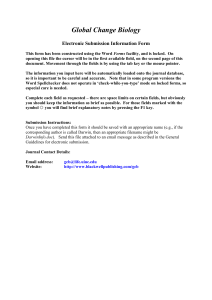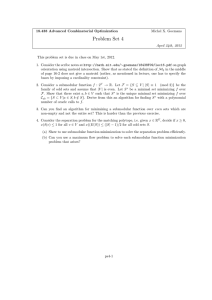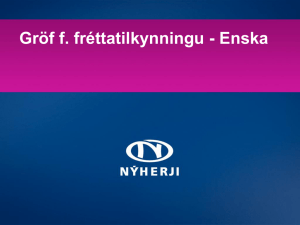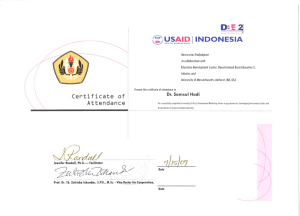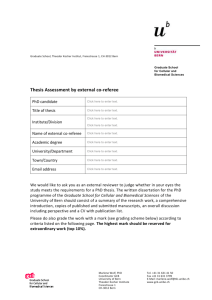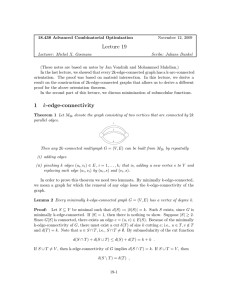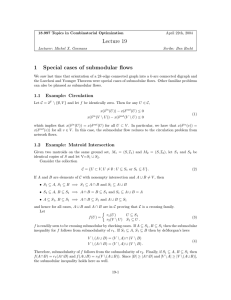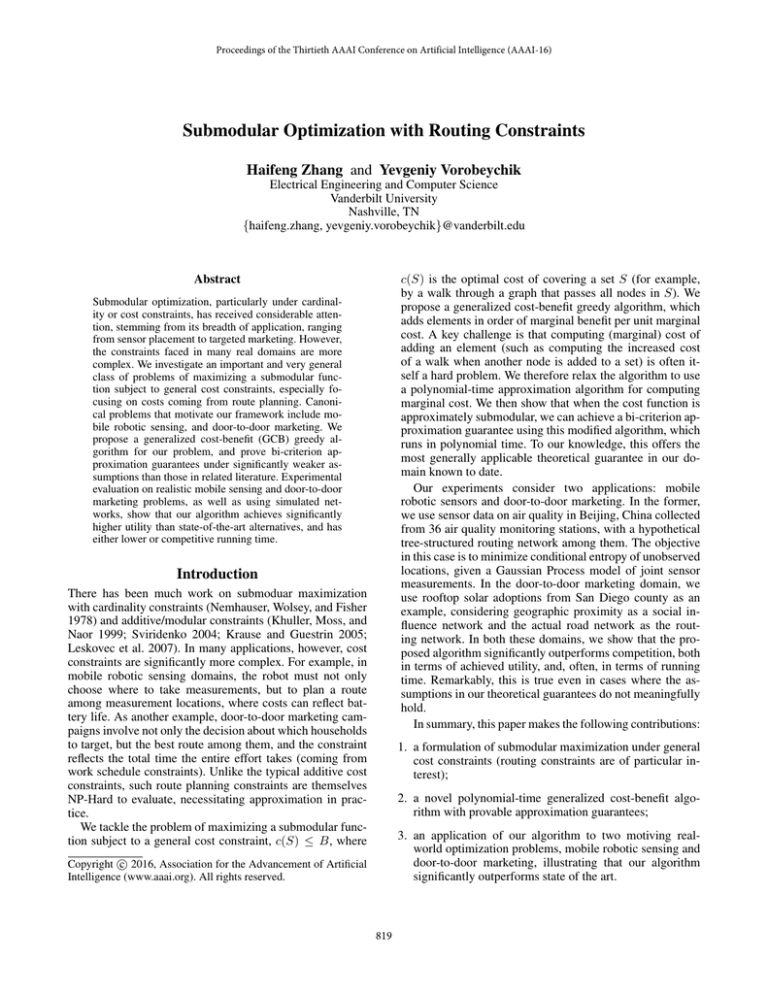
Proceedings of the Thirtieth AAAI Conference on Artificial Intelligence (AAAI-16)
Submodular Optimization with Routing Constraints
Haifeng Zhang and Yevgeniy Vorobeychik
Electrical Engineering and Computer Science
Vanderbilt University
Nashville, TN
{haifeng.zhang, yevgeniy.vorobeychik}@vanderbilt.edu
c(S) is the optimal cost of covering a set S (for example,
by a walk through a graph that passes all nodes in S). We
propose a generalized cost-benefit greedy algorithm, which
adds elements in order of marginal benefit per unit marginal
cost. A key challenge is that computing (marginal) cost of
adding an element (such as computing the increased cost
of a walk when another node is added to a set) is often itself a hard problem. We therefore relax the algorithm to use
a polynomial-time approximation algorithm for computing
marginal cost. We then show that when the cost function is
approximately submodular, we can achieve a bi-criterion approximation guarantee using this modified algorithm, which
runs in polynomial time. To our knowledge, this offers the
most generally applicable theoretical guarantee in our domain known to date.
Our experiments consider two applications: mobile
robotic sensors and door-to-door marketing. In the former,
we use sensor data on air quality in Beijing, China collected
from 36 air quality monitoring stations, with a hypothetical
tree-structured routing network among them. The objective
in this case is to minimize conditional entropy of unobserved
locations, given a Gaussian Process model of joint sensor
measurements. In the door-to-door marketing domain, we
use rooftop solar adoptions from San Diego county as an
example, considering geographic proximity as a social influence network and the actual road network as the routing network. In both these domains, we show that the proposed algorithm significantly outperforms competition, both
in terms of achieved utility, and, often, in terms of running
time. Remarkably, this is true even in cases where the assumptions in our theoretical guarantees do not meaningfully
hold.
In summary, this paper makes the following contributions:
Abstract
Submodular optimization, particularly under cardinality or cost constraints, has received considerable attention, stemming from its breadth of application, ranging
from sensor placement to targeted marketing. However,
the constraints faced in many real domains are more
complex. We investigate an important and very general
class of problems of maximizing a submodular function subject to general cost constraints, especially focusing on costs coming from route planning. Canonical problems that motivate our framework include mobile robotic sensing, and door-to-door marketing. We
propose a generalized cost-benefit (GCB) greedy algorithm for our problem, and prove bi-criterion approximation guarantees under significantly weaker assumptions than those in related literature. Experimental
evaluation on realistic mobile sensing and door-to-door
marketing problems, as well as using simulated networks, show that our algorithm achieves significantly
higher utility than state-of-the-art alternatives, and has
either lower or competitive running time.
Introduction
There has been much work on submoduar maximization
with cardinality constraints (Nemhauser, Wolsey, and Fisher
1978) and additive/modular constraints (Khuller, Moss, and
Naor 1999; Sviridenko 2004; Krause and Guestrin 2005;
Leskovec et al. 2007). In many applications, however, cost
constraints are significantly more complex. For example, in
mobile robotic sensing domains, the robot must not only
choose where to take measurements, but to plan a route
among measurement locations, where costs can reflect battery life. As another example, door-to-door marketing campaigns involve not only the decision about which households
to target, but the best route among them, and the constraint
reflects the total time the entire effort takes (coming from
work schedule constraints). Unlike the typical additive cost
constraints, such route planning constraints are themselves
NP-Hard to evaluate, necessitating approximation in practice.
We tackle the problem of maximizing a submodular function subject to a general cost constraint, c(S) ≤ B, where
1. a formulation of submodular maximization under general
cost constraints (routing constraints are of particular interest);
2. a novel polynomial-time generalized cost-benefit algorithm with provable approximation guarantees;
3. an application of our algorithm to two motiving realworld optimization problems, mobile robotic sensing and
door-to-door marketing, illustrating that our algorithm
significantly outperforms state of the art.
c 2016, Association for the Advancement of Artificial
Copyright Intelligence (www.aaai.org). All rights reserved.
819
Problem Statement
Related Work
Let V be a collection of elements and f : 2V → R≥0 a
function over subsets of V , and assume that f is monotone
increasing. For any S ⊆ V , define f (j|S) = f (S ∪ j) −
f (S), that is, the marginal improvement in f if element j ∈
V is added to a set S ⊂ V . Our discussion will concern
submodular functions f , which we now define.
Definition 1. A function f : 2V → R≥0 is submodular if
for all S ⊆ T ⊆ V , f (j|S) ≥ f (j|T ).
Our goal is to find a set S ∗ ⊆ V which solves the following problem:
Submodular optimization has received much attention due
to its breadth of applicability, with applications including viral marketing, information gathering, image segmentation, and document summarization (Fujishige 2005;
Krause and Golovin 2012). A number of efforts consider submodular optimization under cardinality or additive cost constraints (Nemhauser, Wolsey, and Fisher 1978;
Khuller, Moss, and Naor 1999; Sviridenko 2004; Krause
and Guestrin 2005; Leskovec et al. 2007), demonstrating the
theoretical and practical effectiveness of simple greedy and
cost-benefit algorithms in this context. The problem of minimizing travel cost to cover a set of nodes on a graph, which
gives rise to our constraints, is a variant of the Traveling
Salesman Problem (TSP), although in our variations we allow visiting the same nodes multiple times (this variation is
sometimes called the Steiner TSP, or STPS) (Lam and Newman 2008). We adopt a well-known algorithm for approximating the shortest coverage route, referred to as a nearestneighbor heuristic (Rosenkrantz, Stearns, and Lewis 1977).
However, our results and approach are general, and admit
alternative approximation algorithms, such as that proposed
by Christofides (1976) which offers a 3/2 approximation factor. Moreover, it is known that TSP has submodular walk
length on tree-structured graphs (Herer 1999), which motivates our relaxed submodularity assumption on the cost
function due to (Alkalay-Houlihan and Vetta 2014).
f (S ∗ ) = max{f (S) | c(S) ≤ B},
(1)
V
where c : 2 → R≥0 is the cost function, which we assume
is monotone increasing.
An important motivating setting for this problem is when
the cost function represents a least-cost route through a set of
vertices S on a graph. Specifically, suppose that GR (V, E) is
a graph in which V are nodes and E edges, and suppose that
traversing an edge e ∈ E incurs a cost ce , whereas visiting
a vertex v ∈ V incurs a cost cv . For a given set of nodes
S ⊆ V , define a cost cR (S) as the shortest walk in GR that
passes through all nodes in S at least once. The cost function
for S then becomes
cs ,
c(S) = cR (S) +
s∈S
that is, the total coverage cost (by a shortest walk through
the graph), together with visit cost, for nodes in S.
A variation on the problem we study is the Orienteering
Problem (OP), in which the goal is to maximize a total score
collected from visiting vertices on a graph, subject to a travel
time constraint (Golden, Levy, and Vohra 1987; Vansteenwegen, Souffriau, and Van Oudheusden 2011). Chekuri and
Pal (2005) propose a quasi-polynomial time approximation
algorithm that yields a logarithmic approximation guarantee
for a more general submodular objective function. Singh et
al. (2007) show that how this algorithm can be scaled up,
and present results on planning informative paths for robotic
sensors. However, our experimental results suggest that the
running time of this algorithm is orders of magnitude slower
than alternatives (including our proposed algorithm), and we
therefore do not consider it in detail.
Generalized Cost-Benefit Algorithm
Maximizing submodular functions in general is NPhard (Khuller, Moss, and Naor 1999). Moreover, even computing the cost function c(S) is NP-hard in many settings,
such as when it involves computing a shortest walk through
a subset of vertices on a graph (a variant of the traveling salesman problem). Our combination of two hard problems seems hopeless. We now present a general cost-benefit
(GCB) algorithm (Algorithm 1) for computing approximate
solutions to Problem 1. In the sections that follow we present
theoretical guarantees for this algorithm under additional assumptions on the cost function, as well as empirical evidence
for the effectiveness of GCB. At the core of the algorithm is
the following simple heuristic: in each iteration i, add to a
set G an element Xi such that
Perhaps the closest, and most practical, alternative to
our algorithm is the framework proposed by Iyer and
Bilmes (2013). Specifically, they consider submodular maximization under a submodular cost constraint, and propose
several algorithms, including a greedy heuristic (GR) and
iterative submodular knapsack (ISK) (their third proposed
algorithm, involving ellipsoidal approximation of the submodular cost, scales poorly and we do not consider it). Our
approach is a significant extension compared to Iyer and
Bilmes (2013) and Iyer (2015): we present a new generalized cost-benefit algorithm, and demonstrate bi-criterion
approximation guarantees which relax the submodularity assumption on the cost function made by Iyer. This generalization is crucial, as routing costs are in general not submodular (Herer 1999). Moreover, we demonstrate that our algorithm outperforms that of Iyer and Bilmes in experiments.
Xi = arg max
X∈E\Gi−1
f (X|Gi−1 )
,
c(X|Gi−1 )
(2)
where G0 = ∅ and Gi = {X1 , . . . , Xi }. The simple heuristic alone has an unbounded approximation ratio, which is
shown for a modular cost function by Khuller, Moss, and
Naor (1999). The key modification is to return the better of
this solution and the solution produced by a greedy heuristic
that ignores the cost altogether. Next, we observed that c(·)
may not be computable in polynomial time. We therefore
make use of an approximate cost function ĉ(·) in its place
which can be computed in polynomial time. The nature of
820
Data: B > 0
Result: Selection S ⊆ V
A := arg max{f (X)|X ∈ V, ĉ(X) ≤ B};
G := ∅;
V := V ;
while V = ∅ do
foreach X ∈ V do
ΔX
f := f (G ∪ X) − f (G);
ΔX
c := ĉ(G ∪ X) − ĉ(G);
end
X
X ∗ = arg max{ΔX
f /Δc |X ∈ V };
if ĉ(G ∪ X ∗ ) ≤ B then
G := G ∪ X ∗ ;
end
V := V \X ∗
end
return arg maxS∈{A,G} f (S)
Algorithm 1: Generalized Cost-benefit Algorithm.
As mentioned earlier, since optimal cost is often infeasible to compute, our GCB algorithm makes use of approximate cost function, ĉ. We now make this notion of approximation formal: we assume that ĉ is a ψ(n)-approximation
of the optimal cost, where n = |V |. In other words,
c(X) ≤ ĉ(X) ≤ ψ(n)c(X). For example, if an algorithm for TSP is a 3/2-approximation (as is the algorithm
by Christofides (1976)), ψ(n) = 3/2 (independent of problem size). Below we use a much faster and simpler algorithm, nearest neighbor, which is a log(n)-approximation.
Finally, we introduce another useful piece of notation,
defining
Kc = max{|X| : c(X) ≤ B},
that is, Kc is the largest set X ⊆ V which is feasible for our
problem.
Armed with these notions, we are now ready to prove a bicriterion approximation guarantee on GCB, which presents
a bound on the solution quality compared to the optimal solution with a slightly relaxed budget constraint.
Suppose the GCB algorithm starts with an empty set
G0 = ∅, and keeps adding nodes the set by the greedy rule
(Equation 2). It generates a sequence of intermediate sets,
G1 , . . . , Gl , until iteration l + 1 when it violates the budget
constraint and stops with set Gl+1 .
our results will then depend on the quality of this approximation. Observe that, the greedy solution, A, in Algorithm 1
contains only a single element. However, a variant of this is
to continue adding more elements until we violate the budget
constraint. Similarly, when the budget constraint in GCB is
saturated, we can continue adding elements that are not firstbest, until no elements can be added. We show below that
these variations yield the same approximation guarantees.
Our implementations, however, use these enhancements.
Lemma 1. For i=1, . . . , l+1, it holds that
f (Gi ) − f (Gi−1 ) ≥
where ĉ is an α submodular ψ(n)-approximation of the αsubmodular function c and X̃ is the optimal solution of
c −1)(1−kc ))
max{f (X)|c(X) ≤ α B(1+α(K
}.
ψ(n)Kc
Theoretical Analysis
The proof of this lemma is quite involved, making use of a
series of auxiliary results, and is provided in the extended
version of the paper.1
A major limitation of prior work on cost-constrained submodular maximization is that the cost function itself was assumed to be submodular. In most practical problems where
the cost function is generated by routing problems (such
as coverage of nodes on a graph, or TSP), the optimal
cost is not submodular (Herer 1999). On the other hand,
TSP has submodular special cases, such as when the graph
is a tree (Herer 1999). Motivated by this observation, we
make use of a natural relaxation of cost submodularity, αsubmodularity.
Lemma 2. For i = 1, . . . , l + 1 it holds that
i
ĉ(Gk ) − ĉ(Gk−1 )
f (Gi ) ≥ 1 −
) f (X̃)
(1 −
B
k=1
where ĉ is an α-submodular ψ(n)-approximation of an αsubmodular function c, and X̃ is the optimal solution of
c −1)(1−kc ))
max{f (X)|c(X) ≤ α B(1+α(K
}.
ψ(n)Kc
Definition 2. For a cost function c, we define it as αsubmodular for
α = min
x
min
A,B:A⊂B
Proof. For i = 1, we need to prove that
c(x|A)
.
c(x|B)
ĉ(G1 ) − ĉ(G0 )
f (X̃).
B
Clearly, this follows from Lemma 1. Let i > 1, we have
f (G1 ) ≥
In addition, just as in prior work, we need another notion for a function c, termed curvature, which essentially
measures deviations from linearity (Conforti and Cornuéjols
1984; Iyer, Jegelka, and Bilmes 2013).
f (Gi ) = f (Gi−1 ) + [f (Gi ) − f (Gi−1 )] ≥
ĉ(Gi ) − ĉ(Gi−1 )
f (Gi−1 ) +
(f (X̃) − f (Gi−1 ))
B
ĉ(Gi ) − ĉ(Gi−1 )
f (Gi−1 ) +
= 1−
B
Definition 3. For a submodular function c over subsets of
V , total curvature kc is defined as
kc = 1 − min
j∈V
ĉ(Gi ) − ĉ(Gi−1 )
(f (X̃) − f (Gi−1 ))
B
c(j|V \j)
,
c(j)
1
821
See http://vorobeychik.com/2016/gcb.pdf.
ĉ(Gi ) − ĉ(Gi−1 )
f (X̃)
B
ĉ(Gi ) − ĉ(Gi−1 )
≥ 1−
B
i−1
ĉ(Gk ) − ĉ(Gk−1 )
1−
) f (X̃) +
(1 −
B
Experiments
We implement the GBC algorithm to solve two realistic
submodular maximization problems: mobile robotic sensing and door-to-door solar marketing, using both real and
simulated networks. We show that the proposed GCB algorithm outperforms state-of-the-art alternatives, particularly
when routing problems do not yield a submodular optimal
cost function. We compare GCB to two state-of-the-art algorithms: simple greedy (GR) and iterative submodular knapsack (ISK).2 All experiments were performed on an Ubuntu
Linux 64-bit PC with 32 GB RAM and an 8-core Intel Xeon
2.1 GHz CPU. Each experiment used a single thread.
k=1
ĉ(Gi ) − ĉ(Gi−1 )
f (X̃)
B
i
ĉ(Gk ) − ĉ(Gk−1 )
= 1−
) f (X̃)
(1 −
B
k=1
30
Entropy
15 20
10
5
0
0
20
50
200
5
10
15
Node Cost
(d)
50
20
1000
100
Budget
150
200
150
200
GCB
GR
ISK
0
0
0
0
(c)
GCB
GR
ISK
0
Running Time (ms)
200 400 600 800
150
(b)
GCB
GR
ISK
Running Time (ms)
200 400 600 800
1000
(a)
100
Budget
1000
10
15
Node Cost
Running Time (ms)
200 400 600 800
5
GCB
GR
ISK
25
25
10
5
0
0
0
50
100
Budget
(e)
150
200
0
50
100
Budget
(f)
Figure 1: Entropy (a)-(c) & run time (d)-(f) comparison
among algorithms for mobile robotic sensing scenario. (a),
(d) As a function of visit (sensing) cost, fixing budget at 200.
(b), (e) As a function of budget, fixing visit cost = 0. (c), (f)
As a function of budget, fixing visit cost = 10.
Consider the following problem. A mobile robot equipped
with sensors wants to optimally choose a subset of locations
in a 2-D space to make measurements. A common criterion
guiding such a choice is to minimize conditional entropy of
unobserved locations of interest or, equivalently, maximize
entropy of selected locations (Krause, Singh, and Guestrin
2008).3 We suppose that the robot faces two kinds of costs
(e.g., reflecting battery life or time): costs of moving between a pair of neighboring locations, and costs of making
measurements at a particular location.
Our experiments use sensor data representing air quality
measurements for 36 air quality monitoring stations in Beijing, China (Zheng, Liu, and Hsieh 2013), where we limit
attention to temperature. We fit a multivariate Gaussian distribution to this data, and focus on a random subset of locations as the focus of prediction. We generated a hypothetical
where the first inequality follows from Lemma 2 and the
second inequality follows form the fact that ĉ(Gl+1 ) > B,
since it violates the budget. Moreover, by submodularity, we
note that f (Gl+1 ) − f (Gl ) ≤ f (Xl+1 ) ≤ f (X ∗ ), where
X ∗ = arg maxX∈E f (X). Therefore,
f (Gl ) + f (X ∗ ) ≥ f (Gl+1 ) ≥ (1 − 1/e)f (X̃)
max{f (Gl ), f (X ∗ )} ≥
0
5
where X̃ is the optimal solution of max{f (X)|c(X) ≤
c −1)(1−kc ))
}, ĉ is an α-submodular ψ(n)α B(1+α(K
ψ(n)Kc
approximation of an α-submodular function c.
Proof. Observe
that for a1 , . . . , an ∈ R+ , such that ai =
n
A, 1 − i=1 (1 − aAi ) achieves its minimum at a1 = . . . =
an = A
n . It follows that
l+1 ĉ(Gk ) − ĉ(Gk−1 )
f (X̃)
f (Gl+1 ) ≥ 1 −
1−
B
k=1
l+1 ĉ(Gk ) − ĉ(Gk−1 )
1−
f (X̃)
≥ 1−
ĉ(Gl+1 ))
k=1
l+1 1
f (X̃)
≥ 1− 1−
l+1
1
≥ 1−
f (X̃)
e
GCB
GR
ISK
Entropy
15 20
25
Entropy
15 20
1
(1 − e−1 )f (X̃),
2
and
GCB
GR
ISK
10
f (X) ≥
30
Theorem 1. The GCB algorithm obtains a set X such that
30
Case Study 1: Mobile Robotic Sensing
1
(1 − 1/e)f (X̃)
2
Having established a general approximation ratio for
GCB, note that an exactly submodular cost function emerges
as a special case with α = 1, as does exact cost function
when ψ(n) = 1, with the bound becoming tighter in both
instances. Moreover, the bound becomes tighter as we approach modularity.
2
We have attempted to apply several other algorithms, but these
two are the only candidates that scale to non-trivial problem instances.
3
This objective is known to be submodular.
822
a tree-structure routing network (see the Supplement), and
assume that the robot must return to the starting location.
The GCB algorithm starts with an empty set A0 = ∅ and
iteratively adds to Ai a location x∗ with highest ratio of conditional entropy to marginal cost,
x∗ = arg max
x
Adoption of Visible Technology Our first influence network was generated to represent adoption of a highly visible technology, such as rooftop solar (Zhang et al. 2015).
Specifically, when a technology is visible, the primary social influence effect stems from geographic proximity; thus,
in the case of rooftop solar adoption, adoption has been
shown to have significant influence on geographic neighbors (Zhang et al. 2015). For this use case, we therefore take
a household dataset for San Diego county, and induce a social influence network based on proximity as measured by a
165 foot radius, giving rise to the influence network shown
in Figure 2 (left). Figure 2 (right) shows the corresponding
H(x|Ai )
,
c(x|Ai )
where
1
2
log(2πeσx|A
)
i
2
is the conditional entropy of x given selection of Ai and
c(x|Ai ) is the marginal cost of covering x if we already
cover Ai . We use the Nearest Neighbor (NN) algorithm to
compute approximately optimal routing cost (Rosenkrantz,
2
Stearns, and Lewis 1977). The conditional variance, σx|A
,
i
can be obtained as follows:
H(x|Ai ) =
2
σx|A
= K(x, x) − ΣxAi Σ−1
Ai A i Σ Ai x ,
i
where K(x, x) is the variance of location x, ΣxAi is a vector of covariances K(x, u), ∀u ∈ Ai , ΣAi Ai the covariance
submatrix corresponding to measurements Ai , and ΣAi x is
the transpose of ΣxAi . Figure 1 shows the results of entropy
(performance) and running time comparison between GCB
and the two previous approaches (GR and ISK). GCB nearly
always outperforms the other two, often by a large margin,
in terms of entropy; GR is particularly weak in most comparisons. Moreover, GCB has competitive running time with
GR, and scales far better than ISK.
Figure 2: Top: social influence network arising from geographic proximity. Bottom: corresponding routing network.
Case Study 2: Door-to-door Marketing of Rooftop
Solar Photovoltaic Systems
Our next investigation focuses on door-to-door marketing problem, which we cast as social influence maximization (Kempe, Kleinberg, and Tardos 2003) under routing constraints. We formalize this problem by considering
two interdependent networks: the social influence network,
which captures the influence adopters (of a product) have
on the likelihood that others adopt, and the routing network,
which represents routes taken by a marketer to visit households of choice. The goal of the marketer is to select a subset
of individuals on a network maximizing overall social influence, subject to cost (e.g., time) constraints. Below we
consider both real and simulated networks. Whatever the
choice of the network, we use the well-known independent
cascade (IC) model to compute social influence of a subset
of nodes (Kempe, Kleinberg, and Tardos 2003). In the IC
model, given a subset of nodes initially seeded, each neighbor w of an adopter v is independently influenced to adopt
with probability pvw , and this adoption cascade process iteratively repeats until no new nodes adopt. The expected final number of adopters after this process terminates is denoted by σ(A), where A is the set of initially seeded nodes.
Kempe, Kleinberg, and Tardos (2003) showed that the function σ(A) is monotone submodular. In our experiments below, we used pvw = 0.1 for all network edges (v, w). Since
the IC model is stochastic in nature, we run it 1000 times to
estimate σ(A).
routing network obtained from OpenStreetMap, where red
dots are way points or intersections in the road networks.
The costs of edges in the routing network correspond to
physical distance.
Figure 3 shows the results of comparing our GCB algorithm to GR and ISK, both in terms of achieved average influence, and running time. In all cases, we can observe that
GCB outperforms the others on both measures, often by a
substantial margin. Particularly striking is the running time
comparison with ISK, where the difference can be several
orders of magnitude.
Our final experimental investigation involves random
graph models for both social influence propagation and routing. In particular, we use the well-known Barabasi-Albert
(BA) model (Albert and Barabási 2002) to generate a random social network (a natural choice, since BA model has
been shown to exhibit a scale-free degree distribution, which
is a commonly observed feature of real social networks),
and the Erdos-Renyi (ER) model to generate the routing network (Erdos and Renyi 1959).
The BA model is an iterative generative model which
starts with a small seeded network (e.g., a triangle), and
adds a node one at a time, connecting it to m vertices,
with each edge using the new node as a source generated
with probability proportional to the target node’s degree.
In our implementation, we generated a BA social network
823
50
50
1.5
2.0
(a)
0.8
1.0
50
50
Running Time (s)
20
30
40
Running Time (s)
20
30
40
10
10
0.4
0.6
Visit Cost
0.8
0
200
200
2
4
6
Budget
8
10
4
6
Budget
8
10
4
6
Budget
8
10
GCB
GR
ISK
Running Time (s)
50
100
150
GCB
GR
ISK
0
0
1.0
0
2
4
6
Budget
8
10
0
2
GCB
GR
ISK
GCB
GR
ISK
0
0.4
0.6
Visit Cost
0.8
1.0
0
2
4
6
Budget
8
(b)
10
0
2
(c)
Figure 5: Run time comparison among algorithms for the
door-to-door marketing scenario on random graphs. Top
row: p = 0.01 in the ER mode. Middle row: p = 0.02.
Bottom row: p = 0.03. (a) As a function of visit (sensing)
cost, fixing budget at 10. (b) As a function of budget, fixing
visit cost = 0. (c) As a function of budget, fixing visit cost =
0.5.
Influence
20
30
40
0.2
(a)
2
4
6
Budget
8
10
p ∈ {0.01, 0.02, 0.03}. To generate routing costs, we randomly assigned coordinates for the 200 nodes in 2-D space,
and use the Euclidean distance between nodes as a proximity
measure.
Figure 4 and Figure 5 show the results for the random
graph experiments, which are consistent with the observations so far: GCB tends to outperform alternative algorithmic approaches both in terms of objective value (influence,
in this case), and in terms of running time (it is comparable to GR, and much faster than ISK). Interestingly, in some
cases GR or ISK have comparable objective value to GCB,
but in almost all cases the other algorithm is far worse, and
the relative performance of GR and ISK is not consistent:
either one is sometimes observed to be better than the other.
We can also note that as p increases (and the routing network
becomes more dense), the running time of ISK increases
rather dramatically, whereas both GCB and GR remain quite
scalable.
Influence
40
60
80
GCB
GR
ISK
0
8
0
10
100
4
6
Budget
2
4
6
Budget
8
10
4
6
Budget
8
10
GCB
GR
ISK
80
GCB
GR
ISK
Influence
40
60
Influence
40
60
0.4
0.6
Visit Cost
0.2
GCB
GR
ISK
0.0
20
Influence
40
60
2
20
0
0
0.2
0
10
20
Influence
40
60
20
0
0.0
10
0
8
0
GCB
GR
ISK
80
0
1.0
100
0.8
8
200
1.0
Budget
GCB
GR
ISK
100
4
6
Budget
GCB
GR
ISK
80
0.4
0.6
Visit Cost
4
6
Budget
Running Time (s)
50
100
150
0.5
10
Influence
20
30
10
2
20
Influence
40
60
20
0
0.2
100
0.0
GCB
GR
ISK
2
0
0.0
(f)
0
100
GCB
GR
ISK
80
0
1.0
80
0.8
0
1.0
300
2.0
GCB
GR
ISK
40
100
80
Influence
40
60
20
0
0.4
0.6
Visit Cost
0.8
Running Time (s)
100
200
1.5
(e)
100
0.2
0.4
0.6
Visit Cost
50
1.0
Budget
Figure 3: Influence σ (a)-(c) & run time (d)-(f) comparison
among algorithms for the door-to-door marketing scenario
with visible technology. (a), (d) As a function of visit (sensing) cost, fixing budget at 3. (b), (e) As a function of budget,
fixing visit cost = 0. (c), (f) As a function of budget, fixing
visit cost = 0.1.
0.0
0.2
0
Running Time (s)
2000
6000
0.5
(d)
GCB
GR
ISK
0
20
0
GCB
GR
ISK
0.0
0.0
1.0
0.0
2.0
0
0.8
1.5
400
0.4
0.6
Visit Cost
1.0
Budget
GCB
GR
ISK
0
0
0.2
0.5
(c)
GCB
GR
ISK
0
2000
Running Time (s)
6000
10000
GCB
GR
ISK
0.0
0.0
Running Time (s)
50
100
150
2.0
GCB
GR
ISK
0
1.5
(b)
10000
(a)
1.0
Budget
200
0.5
Running Time (s)
50
100
150
0.0
1.0
Running Time (s)
100
200
300
0.8
2000
0.4
0.6
Visit Cost
Running Time (s)
500
1000 1500
0.2
0
0
50
0.0
GCB
GR
ISK
Running Time (s)
40
60
80
Influence
100
150
GCB
GR
ISK
50
50
100
200
200
GCB
GR
ISK
Influence
100
150
250
Influence
100 150 200
GCB
GR
ISK
0
2
4
6
Budget
(b)
8
10
0
2
(c)
Figure 4: Influence σ comparison among algorithms for
the door-to-door marketing scenario on random graphs. Top
row: p = 0.01 in the ER mode. Middle row: p = 0.02. Bottom row: p = 0.03. (a) As a function of visit (sensing) cost,
fixing budget at 10. (b) As a function of budget, fixing visit
cost = 0. (c) As a function of budget, fixing visit cost = 0.5.
Conclusion
We considered a very general class of problems in which
a monotone increasing submodular function is maximized
subject to a general cost constraint. This problem is motivated by two very different applications: one is mobile
robotic sensing, in which a robot moves through an environment with the goal of making select sensor measurements to make predictions about a location which is in-
over 200 nodes, adding m = 2 edges in each iteration.
The ER model is the simplest generative model of networks, where each edge is added to the network with a fixed
probability p. In our experiments, we considered values of
824
feasible to measure, and another in door-to-door marketing. In both of these applications, the cost constraints arise
from routing costs, as well as costs to visit nodes (e.g., to
make sensor measurements or to make a marketing pitch).
Our algorithmic contribution was a novel generalized costbenefit algorithm, for which we showed bi-criterion approximation guarantees with a relaxed notion of cost submodularity as well as allowing optimal cost to be only approximately
computed. Through an extensive experimental evaluation on
both real and synthetic graphs we showed that our algorithm
outperforms state-of-the-art alternatives both in terms of objective value achieved (often significantly) and running time.
Moreover, we dramatically outperform an iterative submodular knapsack algorithm in terms of runtime, and have a
competitive runtime with a greedy algorithm, which tends
to perform poorly in terms of objective.
Iyer, R. K.; Jegelka, S.; and Bilmes, J. A. 2013. Curvature and optimal algorithms for learning and minimizing
submodular functions. In Advances in Neural Information
Processing Systems, 2742–2750.
Iyer, R. K. 2015. Submodular Optimization and Machine
Learning: Theoretical Results, Unifying and Scalable Algorithms, and Applications. Ph.D. Dissertation.
Kempe, D.; Kleinberg, J.; and Tardos, É. 2003. Maximizing
the spread of influence through a social network. In Proceedings of the ninth ACM SIGKDD international conference on
Knowledge discovery and data mining, 137–146. ACM.
Khuller, S.; Moss, A.; and Naor, J. S. 1999. The budgeted
maximum coverage problem. Information Processing Letters 70(1):39–45.
Krause, A., and Golovin, D. 2012. Submodular function
maximization. Tractability: Practical Approaches to Hard
Problems 3:19.
Krause, A., and Guestrin, C. 2005. A note on the budgeted
maximization of submodular functions.
Krause, A.; Singh, A.; and Guestrin, C. 2008. Near-optimal
sensor placements in gaussian processes: Theory, efficient
algorithms and empirical studies. The Journal of Machine
Learning Research 9:235–284.
Lam, F., and Newman, A. 2008. Traveling salesman path
problems. Mathematical Programming 113(1):39–59.
Leskovec, J.; Krause, A.; Guestrin, C.; Faloutsos, C.; VanBriesen, J.; and Glance, N. 2007. Cost-effective outbreak
detection in networks. In Proceedings of the 13th ACM
SIGKDD international conference on Knowledge discovery
and data mining, 420–429. ACM.
Nemhauser, G. L.; Wolsey, L. A.; and Fisher, M. L. 1978.
An analysis of approximations for maximizing submodular
set functionsi. Mathematical Programming 14(1):265–294.
Rosenkrantz, D. J.; Stearns, R. E.; and Lewis, II, P. M. 1977.
An analysis of several heuristics for the traveling salesman
problem. SIAM journal on computing 6(3):563–581.
Singh, A.; Krause, A.; Guestrin, C.; Kaiser, W. J.; and
Batalin, M. A. 2007. Efficient planning of informative paths
for multiple robots. In IJCAI, volume 7, 2204–2211.
Sviridenko, M. 2004. A note on maximizing a submodular
set function subject to a knapsack constraint. Operations
Research Letters 32(1):41–43.
Vansteenwegen, P.; Souffriau, W.; and Van Oudheusden, D.
2011. The orienteering problem: A survey. European Journal of Operational Research 209(1):1–10.
Zhang, H.; Vorobeychik, Y.; Letchford, J.; and Lakkaraju,
K. 2015. Data-driven agent-based modeling, with application to rooftop solar adoption. In Proceedings of the 2015
International Conference on Autonomous Agents and Multiagent Systems, 513–521. International Foundation for Autonomous Agents and Multiagent Systems.
Zheng, Y.; Liu, F.; and Hsieh, H.-P. 2013. U-air: When urban
air quality inference meets big data. In Proceedings of the
19th ACM SIGKDD international conference on Knowledge
discovery and data mining, 1436–1444. ACM.
Acknowledgments
This work was partially supported by the U.S. Department
of Energy (DOE) office of Energy Efficiency and Renewable Energy, under the Solar Energy Evolution and Diffusion
Studies (SEEDS) program, the National Science Foundation
(IIS-1526860), and the Office of Naval Research (N0001415-1-2621).
References
Albert, R., and Barabási, A.-L. 2002. Statistical mechanics
of complex networks. Reviews of modern physics 74(1):47.
Alkalay-Houlihan, C., and Vetta, A. 2014. False-name bidding and economic efficiency in combinatorial auctions. In
Proceedings of the Twenty-Eighth AAAI Conference on Artificial Intelligence (AAAI’14), 538–544.
Chekuri, C., and Pal, M. 2005. A recursive greedy algorithm
for walks in directed graphs. In Foundations of Computer
Science, 2005. FOCS 2005. 46th Annual IEEE Symposium
on, 245–253. IEEE.
Christofides, N. 1976. Worst-case analysis of a new heuristic
for the travelling salesman problem. Technical report, DTIC
Document.
Conforti, M., and Cornuéjols, G. 1984. Submodular set
functions, matroids and the greedy algorithm: tight worstcase bounds and some generalizations of the rado-edmonds
theorem. Discrete applied mathematics 7(3):251–274.
Erdos, P., and Renyi, A. 1959. On random graphs i. Publ.
Math. Debrecen 6:290–297.
Fujishige, S. 2005. Submodular functions and optimization,
volume 58. Elsevier.
Golden, B. L.; Levy, L.; and Vohra, R. 1987. The orienteering problem. Naval Research Logistics (NRL) 34(3):307–
318.
Herer, Y. T. 1999. Submodularity and the traveling salesman problem. European journal of operational research
114(3):489–508.
Iyer, R. K., and Bilmes, J. A. 2013. Submodular optimization with submodular cover and submodular knapsack constraints. In Advances in Neural Information Processing Systems, 2436–2444.
825

